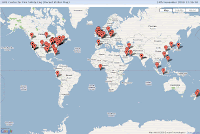
by Dr Guillermo Rein, The University of Edinburgh.
More than 1,100 delegates from 40 countries participated in the 32nd International Symposium on Combustion in Montreal where 7 parallel sessions took place with 5 plenaries, 554 presentations and about 330 posters during the five-day long event. The McGill campus and the city of Montreal were brilliant choices for the venue, providing easy international access, the right facilities and a vibrant cultural atmosphere. The organization was flawless.
This was the third combustion symposium that I attended. I found it very interesting - not only because I learnt about some of the latest developments in combustion science but also because I met some extraordinary people. By attending the ISC, I continue on discovering the roots of the combustion community, the reasons for the path taken in the past and its current aims.
The fire group in Edinburgh presented three papers:
. Small-scale forward smouldering experiments for remediation of coal tar in inert media
. Carbon emissions from smouldering peat in shallow and strong fronts
. Transport mechanisms controlling soot production inside a non-buoyant laminar diffusion flame
Judging from the Symposium plenaries and paper presentations that I attended or read (about 40 of them), the combustion research community has largely focused again on the fundamental research of topics like detailed chemistry, turbulence models and engines/turbines. This feeling is confirmed by reviewing the programme where these three topics were the focus of 35-45% of the talks. Of the 12 colloquia that made the programme, one was dedicated to Fire Research, my expertise. In this colloquium, there were 31 presentations and 20 work-in-progress posters on fire topics that included fundamental aspects of fires, flame spread, radiation effects, combustion suppression, and fire and the environment.
At times, I had the impression that I had already been there. Similarities, in general lines, with previous symposium contents were patent. From my point of view, there were not many breakthroughs but a general lack of exciting topics, with a few exceptions like the plenary lecture of Prof. Sawyer on energy and environmental problems, the talk of Dr Linne on ballistic imaging, and others. The Symposium contained little applied research and little new topics (ie. less that 3% of the papers addressed new technology concepts). In the meantime, some of the biggest scientific concerns of our time are directly linked to combustion processes but largely ignored by the combustion community for some reasons. For example, emissions, energy and environmental problems were the focus of less than 1% of the papers.
For the next symposium in Beijing 2010, I personally look forward a wave of stimulating applied research, and fresh ideas from outside the box in addition to new detailed fundamental studies of older topics.
I appreciate the partial financial support of the British Section of the Combustion Institute to attend the symposium.
Dr G. Rein
***
NOTE I: Parts of this report has been published in the 2009 Spring Newsletters of the British Section of the Combustion Institute and The International Association of Fire Safety Science .
NOTE II: I asked Prof. Sawyer via the Combustion Institute website if we were doing enough given the great importance of the energy and environment combustion problems? He replied by saying "The debate over the Combustion Institute's role, whether to focus solely on high quality science or to venture into advocacy, has been ongoing for decades. Past decisions to avoid advocacy deserve review. The participation of the new generation of combustion scientists in this debate is essential"
NOTE III: The 5 Plenary Lectures of the Symposium can be watch here
















